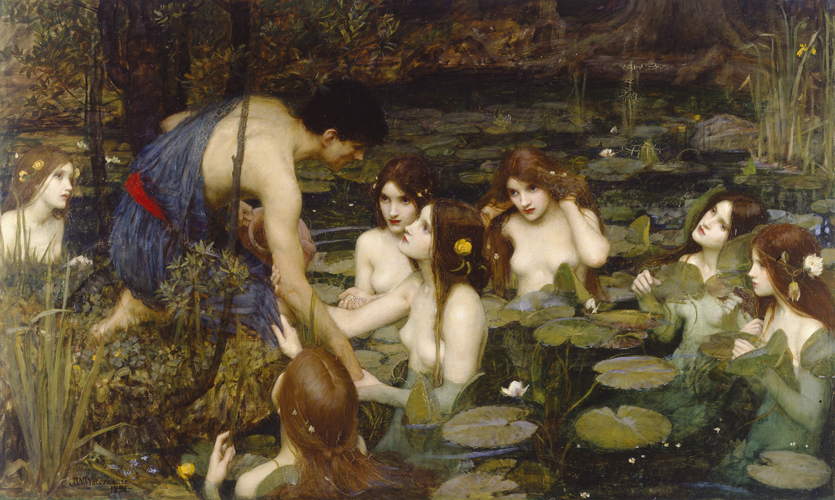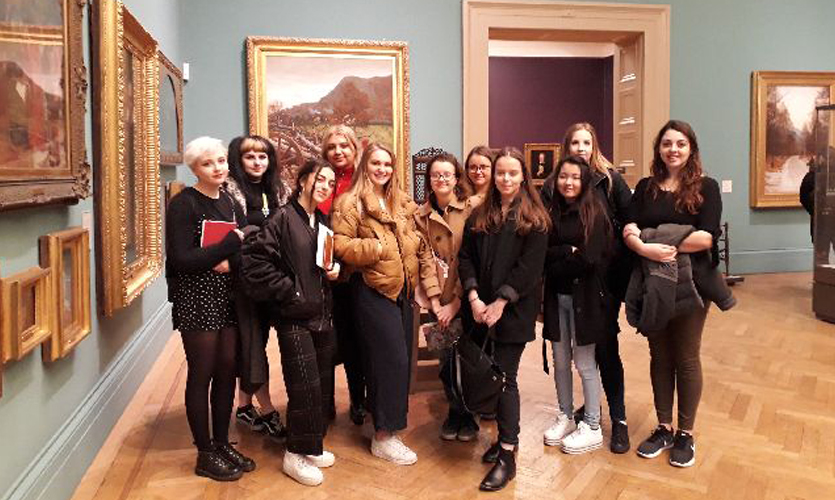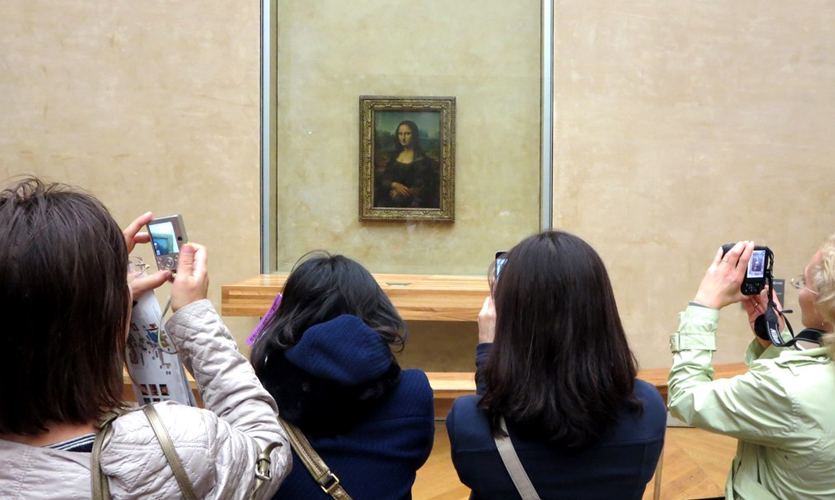Does this painting offend you?

The gallery claims that its actions were designed to spark a public debate. According to The Guardian coverage of the story, Clare Gannaway, the gallery’s curator of contemporary art, said the aim of the removal was to provoke debate, not to censor: “It wasn’t about denying the existence of particular artworks”. The move created lots of media headlines and the gallery featured on daily news broadcasts that day, trended on Twitter and created energetic (and often angry) comments across social media. But, will the action make a long-lasting impact on the debate currently circulating around equality, #MeToo and the role of women in society?
Dr Juliet Carroll, senior lecturer in History of Art and Museum Studies, was due to take her first year students on a gallery tour on the day Hylas and the Nymphs (1896) was removed. We asked Juliet and some of her students to tell us what they think about the gallery’s actions and whether it managed to achieve its aims.
This was an inspired decision by the curators. It was unimaginable that a rather worthy late Victorian painting could suddenly attract such controversy and stimulate these heated arguments. Although this was one of the works we travelled to study, we were not disappointed by its removal but have enjoyed a vigorous debate concerning the representation of the female in 21st century culture. Well done, Manchester City Art Gallery.
Caitlin Whittle
Of course we can’t look at Hylas and the Nymphs with the same ethical lens that we look at art created today, however, does that mean we don’t have the right to question the decisions of someone in history? The temporary removal of the JW Waterhouse painting was to provoke a debate about how art of this nature is shown in galleries – I think this was effective in starting a conversation that so desperately needs to be had.
This came soon after the Met Museum in New York refused to remove the unarguably paedophilic painting Therese Dreaming (1938) by Balthus in December. In accordance with the socio-political times we are currently living in, it has become greatly important to look back at public figures, even people we considered national treasures, and expose their unacceptable behaviours no matter how prominent they might be.
Hylas and the Nymphs is a masterpiece but ultimately it is a masterpiece portraying identical-looking teen girls as expressionless ornaments with their breasts exposed; I ask if its cultural importance justifies this display? As an example of Pre-Raphaelite attention to detail? Are there not other examples? People seem to be of the opinion that removing this piece is some overly politically correct statement that is oh-so-typical today when over 100 years ago the suffragettes attacked paintings in Manchester Art Gallery for the same reason.
A century ago Ethel Smyth said: “There is to me something hateful, sinister, sickening in this heaping up of art treasures, this sentimentalising over the beautiful, while the desecration and ruin of bodies of women and little children by lust, disease, and poverty are looked upon with indifference.” With the knowledge that 6 February was the 100th year anniversary of the partial granting of women’s suffrage, this is a timely reminder that a conversation needs to happen about the continuous defence of women being objectified and sexualised in art.
Emma Donnelly
I think the removal of JW Waterhouse’s Hylas and the Nymphs has raised an awareness and started a conversation that may be more important than the iconography and actual content of the painting. In the times of #MeToo, and the current situation of sexual exploitation of women, it is especially crucial to have the conversation of how women are treated and the importance of women. It’s valuable to analyse the painting in its context and carefully relate it to current climates but also to differentiate the two. The history behind the painting is significant and the femme fatale characters represented here are just as prominent when considering the progression women have made in art as well as in everyday life.
|
The decision to remove the painting was crafty, cunning and intelligent. Most importantly, it has started a powerful conversation. |
Matilda Urbani
This action has been very provocative, but that was the aim of the curator: to provoke debate about this painting that was in a room titled “In Pursuit of Beauty”. Although it was explained that the aim of the museum was not to censor the painting, this action opened a heated debate, promoted firstly by the gallery, which, in the empty space left by the painting, invited the public to write their opinion about this choice.
In days where campaigns like #MeToo and #TimesUp are always discussed, where female power is getting stronger, I think that the decision of removing the painting was not totally right. The idea of discussing and challenging the public on themes like feminism and the vision of the woman needs to be appreciated but, probably, this was not the best way to open up such an important and delicate debate.
First of all, paintings are the proof of a country’s history and they should be analysed into the period when they were made. When Waterhouse painted Hylas and the Nymphs the role and the idea of women was completely different. Women were seen like sexual objects with no rights at all. Today this vision has changed and, thankfully, women can express their opinions and stand for their rights. So asking why Waterhouse painted the Nymphs in this way and if it is right for the public to see it makes no sense to me. Those were different times and by seeing a naked female the viewers should be able to, instead, appreciate how the role and the idea of the woman has changed through the time. Personally, as a woman, I would be much more offended by seeing a contemporary artist depicting a girl as a sexual object. Works from the past that represent nude females make me proud of what, through fights and protests, we have been able to achieve today.

Anna Roberts
I feel that the painting portrays a clear sense of eroticism and sensuality due to exposure of the Nymphs’ breasts. For some this has created disgust, due to the objectification of the Nymphs for the pleasure of Hylas. However, I feel less of a sense of disgust, as although the Nymphs symbolise titillation, as it was painted by a man, I believe that the painting is quite classical in its nature, as it is based on an ancient Greek Myth. Many paintings from as early as the Renaissance depict overtly sexualised scenes, and have had no debate or controversy, so I question why the gallery removed this piece; what themes of sexuality has this piece got that are unlike many other classical paintings?
The temporary removal of the painting was an action by contemporary artist Sonia Boyce, who claimed that removal of the artwork would spark a debate about sexualised females, in particular with regards to the #MeToo campaign, in which she explained was a factor in the decision of removing the painting. When analysing this controversy, I felt that it was reminiscent of the time the Mona Lisa was stolen from the Louvre in Paris and was then found two years later. Before the Mona Lisa was stolen it was not a particularly popular painting, however its absence helped to spark debate about about how increased security would help to prevent the looting of future pieces. I believe that this idea reflects the decision of removing the painting Hylas and the Nymphs, as the absence of a piece may help to show how we took the piece for granted and causes us to consider the impact of the painting in our society.

The Mona Lisa: not always this popular. Photo: David Stanley / Flickr / CC BY 2.0
Although many people have a lot of contempt for this removal on social networking sites like Twitter, I believe that we have inadvertently sparked a debate, where people are discussing how this piece should be viewed as a painting of historical context or a reflection on our portrayal of females in society. Art Curator Gannaway claimed that this wasn’t an attempt to “censor” the artwork but to create conversation about how galleries represent art in our society. However, I feel that we should not look at this piece as a reflection of our society but a reflection of the society at the time, as that was when the painting was completed.
Although Boyce also claims that she didn’t intend censorship, a lot of her artwork has commanded censorship with her work which represents the black arts movement of women. I consider this act as a form of censorship as it condemns the artist’s work, thus preventing an artist’s freedom of expression. I also worry that the temporary absence of the painting could lead to the discrediting of the artist, which would be such a travesty, since JW Waterhouse is such a prolific artist of the Pre-Raphaelite era.
When looking into the Pre-Raphaelite era as a movement, it was very socio-political and often challenged institutions and fought for working class people, so in knowing that, why would we silence the artist’s voice of possibly commenting on the sexualisation of women in a socio-political way, as Boyce is trying to convey by removing it? Therefore, I believe that the Gallery should have looked closey into the context of what the painting actually represents before deciding to remove it.
Going back to curator Gannaway’s statement of commenting on how galleries represent artwork in our society, shouldn’t we be commenting on the gallery, instead of the paintings exhibited there? Gannaway mentioned that the piece was formerly held in the room titled “In Pursuit of Beauty”, which she claimed that the title creates a “sense of embarrassment”. I agree with Gannaways’ remark, as the title creates this implication of males in pursuit of female beauty, as many of the paintings were painted by men, showing females in openly sexualised gestures. So, I ask why don’t we criticise the context that the gallery has given to the painting and other paintings within that room, instead of criticising the artist who painted it? I feel that the title “In Pursuit of Beauty” definitely changes the perspective of the painting, indicating that JW Waterhouse was objectifying women, which in my opinion was wrong of the gallery to assume this.
Overall, I truthfully feel that the idea behind taking down a piece of artwork to spark debate is an interesting concept. However, I feel that ultimately it won’t impact us as much as having the piece in a gallery and using the painting to protest the recent news of the #MeToo campaign by exhibiting the work and commenting on the gallery’s action of naming the room “In Pursuit of Beauty” and not criticising the artworks in that space but why the gallery would put them there in the first place. Therefore, I feel that it’s the institutions that we should be criticising, not the artists, in order to demonstrate the objectification of women in art.
Rhianna Atkinson
The removal of JW Waterhouse’s Hylas and The Nymphs sparks a discussion over whether the curator has broken the trust of the public and draws the question of whether they are fit to continue to represent the painting itself. Many people are concerned whether the curator was aware of the context of the piece and what it represents.
Although it does spark debate around current gender issues, which in some cases do deserve censorship, this painting is merely depicting the tragic tale of Hylas and the Nymphs. I do believe that this is merely a disguise to encourage conversation, however, to promote debate would it not be better to show more of what is considered untoward instead of less? The curators of the art gallery are the custodians of the piece not their owners – if they are willing to temporarily remove this piece because of nudity, it raises the question of how many other pieces of art are appropriate to have on display? Inspired by the #MeToo movement, you can’t talk about something by then hiding it from the public; it takes away the main message of the movement, provoking discussion. This is indeed important, but imposing modern issues on history is to misunderstand history itself.
Brilliant provocation or act of censorship? Let us know your opinion in the comments. If you'd like to explore art history in more depth discover more about study in the School of Art and Design.


